Photo
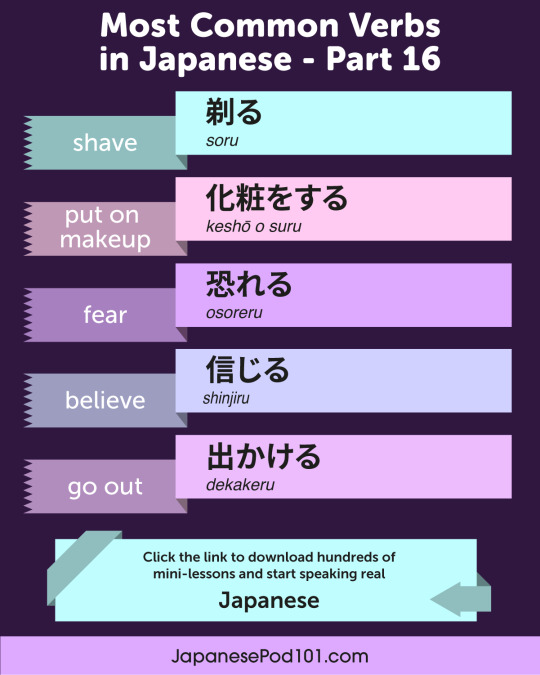
Most Common Verbs in Japanese - Part 16 📢 PS: Learn Japanese with the best FREE online resources, just click here: https://www.japanesepod101.com/?src=facebook_special_infographic_verbs_16_image_111720
104 notes
·
View notes
Text
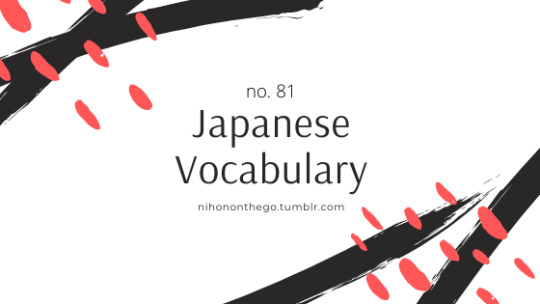
Vocabulary from journal entry no. 79: 論文.
1. 提案 (ていあん、teian) - proposal (n)
私は7月から提案の論文を書いている。
わたしはしちがつからていあんのろんぶんをかいている。
I’ve been writing a dissertation proposal since July.
2. 小中高 (しょうちゅうこう、shouchuukou) - elementary, junior high, high school (K-12) (n)
テーマはオンライン授業に関する小中高の教師の自己効力感だ。
テーマはオンラインじゅぎょうにかんするしょうちゅうこうのきょうしのじここうりょくかんだ。
The topic is about K-12 teachers’ self-efficacy in online teaching.
3. 遂行する (すいこうする、suikou suru) - to accomplish, to execute (v.n.)
自己効力感というのは、自分が仕事を遂行する能力に対する満足感や自信のことだ。
じここうりょくかんというのは、じぶんがしごとをすいこうするのうりょくにたいするまんぞくかんやじしんのことだ。
Self-efficacy is your belief in your own ability to accomplish a task.
4. 教師 (きょうし、kyoushi) - teacher (n)
ストレスのせいで泣いた教師が多い。
ストレスのせいでないたきょうしがおおい。
There are many teachers who have cried due to the stress.
5. 児童 (じどう、jidou) - youth (n)
オンライン授業をするためには、スクリーン越しや種々のツールで間接的にでも児童・生徒の状況を的確に把握できることが大前提です。
オンラインじゅぎょうをするためには、スクリーンごしやしゅじゅのツールかんせつてきにでもじどう・せいとのじょうきょうをてきかくにはあくできることがだいぜんていです。
To teach online, it is important that teachers have a good pedagogy. (or literally, that teachers accurately grasp the situation of children and students through the screen and various tools).
6. 課する (かする、kasuru) - to impose (v)
学区が教師に課している研修では、教授法の代わりにテクノロジーを重視しているように見える。
がっくがきょうしにかしているけんしゅでは、きょうじゅほうのかわりにテクノロジーをじゅうししているようにみえる。
Although districts are training teachers, there seems to be a focus on technology rather than pedagogy.
7. テーマ (teema) - theme, topic (n)
テーマはオンライン授業に関する小中高の教師の自己効力感だ。
The topic is about K-12 teachers’ self-efficacy in online teaching.
8. 不足する (ふそくする、fusoku suru) - to lack (v.n.)
問題は、オンライン授業をするための技術が不足している教師がたくさんいることだ。
もんだいは、オンラインじゅぎょうをするためのぎじゅつがふそくしているきょうしがたくさんいることだ。
The problem is there are many teachers who lack the skills to teach online.
33 notes
·
View notes
Video
Japanese Crime Recreated with CG

137 notes
·
View notes
Text

1. ずっと前に (ずっとまえに、zutto mae ni) - a long time ago (adv.)
ずっと前にリサイクルショップで面白い本を見つけた。
ずっとまえにリサイクルショップでおもしろいほんをみつけた。
I long time ago I found an interesting book at a thrift store.
2. 未婚 (みこん、mikon) - unmarried (n)
神様が夫を与えてくれるのを待っていた未婚の30代のパツィー・ヒラスナについての話だ。
かみさまがおっとをあたえてくれるのをもっていたみこんの30だいのパツィー・ヒラスナについてのはなしだ。
It’s a story about the 30-something unmarried Patsy Hirasuna who was waiting on God to give her a husband.
3. 表紙 (ひょうし、hyoushi) - book cover (n)
赤い扇子の付いた日本っぽい表紙で覆われているオレンジ色の本だった。
あかいせんすのついたにほんっぽいひょうしでおおわれているオレンジいろのほんだった。
It was an orange book with a Japanese-style cover with red fans on it.
4. 仏教徒 (ぶっきょうと、bukkyouto) - Buddhist (n)
パツィーは家族が仏教徒なので、よく家族ともめた。
パツィーはかぞくがぶっきょうとなので、よくかぞくともめた。
Because Patsy’s family were Buddhists, she was often at odds with them.
5. もめる (momeru) - to be at odds with, to disagree with (v)
パツィーは家族が仏教徒なので、よく家族ともめた。
Because Patsy’s family were Buddhists, she was often at odds with them.
6. すっかり忘れていた (すっかりわすれていた、sukkari wasureteita) - completely forgot (phr)
*This phrase can also be used by itself.
財布を持ってくるのをすっかり忘れていた。
さいふをもってくるのをすっかりわすれていた。
I completely forgot to bring my wallet.
7. 哀れに思う (あわれにおもう、aware ni omou) - to feel sorry (v phr)
パツィーは まだ結婚していなかったので、家族から哀れに思われた。
パツィーはまだけっこんしていなかったので、かぞくからあわれにおもわれた。
Because Patsy wasn’t married yet, her family pitied her.
8. 筋書き (すじがき、sujigaki) - synopsis (n)
本はよく筋書きを読まないで買った。
ほんはよくすじがきをよまないでかった。
I bought the book without reading the synopsis.
Related post: No. 59 New Book
235 notes
·
View notes
Video
Net Neutrality is in DEEP Trouble
Reposted from Facebook’s PBS Newshour.
Now that I got your attention with this video…
The FCC decided to go ahead with the vote to remove the Net Neutrality rules that the Obama administration set up.
As you can see, this is what the major ISPs wants to do if they have their way. This can do a few things:
Stiff new innovations, making it harder for smaller companies to compete.
Silence independent voices.
Potentially putting up a “walled garden” on a wide scale.
Make distribution of information harder for low-income people.
Imagine this website, if you will, only working on Verizon networks while AT&T customers are charged a little extra, or have slower access to the same information.
Remember, your ISP owns content providers and may give top-shelf, VIP treatment to their own things while stiffing everyone else. We need to address this.
Now, some of you may recall earlier this year that John Oliver and a lot of other people, companies (and yours truly) did a rallying cry to tell the FCC to back off the Net Neutrality rules, which resulted in millions of comments on their proposal.
However, there’s been a few problems… in short, it seems that the FCC chose to not listen due to “inconsistancies”.
Sidenote: Tumblr isn’t the best place to talk “long-form” so if you’re interested in looking at these notes, here are some places to go to.
https://medium.com/@AGSchneiderman/an-open-letter-to-the-fcc-b867a763850a - “ Specifically, for six months my office has been investigating who perpetrated a massive scheme to corrupt the FCC’s notice and comment process through the misuse of enormous numbers of real New Yorkers’ and other Americans’ identities. Such conduct likely violates state law — yet the FCC has refused multiple requests for crucial evidence in its sole possession that is vital to permit that law enforcement investigation to proceed.”
https://twitter.com/BanditRandom/status/933066570741383169 - A twitter thread about how the Wall Street Journal collected someone’s information to sign in FAVOR of Net Neutrality.
https://arstechnica.com/tech-policy/2017/09/fake-net-neutrality-comments-at-heart-of-lawsuit-filed-against-fcc/ - “Fake” net neutrality comments at heart of lawsuit filed against FCC
So, what can we do about this?
There are a few things you can do to help slow down this nightmare situation.
You can’t just “like” this note, you have to reblog to spread, but more importantly, you have to TAKE action!
1) Make calls to your representatives - https://5calls.org/issue/defend-fcc-net-neutrality - this website will tell you who to call and an easy-to-follow script so that you know exactly what to say.
2) You can support groups like the Electronic Frontier Foundation and the ACLU and Free Press who are fighting to keep Net Neutrality:
https://www.eff.org/
https://www.aclu.org/
https://www.freepress.net/
https://www.fightforthefuture.org/
https://www.publicknowledge.org/
https://www.demandprogress.org/
3) You can add a comment to the proposal using John Oliver’s URL at http://www.gofccyourself.com
4) Write a letter to your representative. Not an email, an actual, snail mail letter.
Let’s all band together and do something about this. Our future of sharing information, building innovation, nurturing voices and creativity depends on your actions now!
I know it may sound hopeless. Look at when they announced this (you probably didn’t know they announced this on Monday when you’re busy getting ready to for the holiday!). But if we say it with one voice to BACK OFF THE NET, we maybe able to make a difference.
64K notes
·
View notes
Text
List of Useful Travel Phrase in Japanese

Below you can find a lot of useful phrase that will help you travel in Japan easier.
If you need more phrases, be sure to check out this app here! You will also find some basic Japanese lessons, sound files, and features to help you study Japanese easier!
…………………………………………
Helpful Phrase
こんにちは konnichiwa: “Hello” or “Good Evening”
お願いします onegaishimasu: please *Learn more about this word*
すみません sumimasen: “Excuse me” or “Sorry”
ありがとうございます arigatou gozaimasu: Thank you
(Place/Location) はどこですか? … wa doko desu ka? : Where is …?
分かりません wakarimasen: I don’t understand
英語話せませんか? eigo hanasemasenka? : Can you speak English?
いくらですか? ikura desu ka?: How much?
…………………………………………
Helpful Words
ここ koko: here
そこ soko: there
あそこ asoko: over there
これ kore: this
それ sore: that
あれ are: that over there
こちら kochira: this way
そちら sochira: that way
あちら achira: that way (over there)
*Did you notice a pattern here? Check this article for more information.
…………………………………………
Places
トイレ toire: toilet
駅 eki: station
バス停 basu tei: bus stop
病院 byouin: hospital
店 mise: shop
公園 kouen: public park
空港 kuukou: airport
…………………………………………
Transportation
電車 densha: train
車 kuruma: car
バス basu: bus
タクシー takushii: taxy
飛行機 hikouki: airplane
…………………………………………
Food
レストラン resutoran: restaurant
英語のメニュー eigo no menyuu: English menu
卵 tamago: egg
豚肉 buta niku: pork
牛肉 gyuu niku: beef
鳥肉 tori niku: chicken meat
お茶 ocha: green tea
ご飯 gohan: rice
野菜 yasai: vegetable
果物 kudamono: fruits
お会計 okaikei: bill
Happy learning °˖✧◝(⁰▿⁰)◜✧˖°
…………………………………………
Useful Links:
• CrunchyNihongo - Easy to Learn Japanese Lessons Site
• Get our easy Japan lessons on your facebook timeline
• FREE DOWNLOAD! Resourceful app to start learning Japanese!
• Books to guide & help you learn Japanese
615 notes
·
View notes
Text
Japanese JLPT Lesson: Expressing “must” with なければならない (nakereba naranai)

Happy learning °˖✧◝(⁰▿⁰)◜✧˖°
…………………………………………
Useful Links:
• CrunchyNihongo - Easy to Learn Japanese Lessons Site
• Get our easy Japan lessons on your facebook timeline
• FREE DOWNLOAD! Resourceful app to start learning Japanese!
• Books to guide & help you learn Japanese
265 notes
·
View notes
Text
Japanese Aisatsu (greetings) list

Common Greetings
おはよう ohayou: Good Morning (from sunrise to 10.00)
おはようございます ohayou gozaimasu: Good Morning (more polite)
こんにちは konnichiwa: Good Evening (from 10.00 to dark)
こんばんは konbanwa: Good Night (once dark)
あきましておめでとう akimashite omedetou: Happy new year (used only after 1st of Jan).
お誕生日おめでとう otanjoubi omedetou: Happy birthday
おめでとう omedetou: Congratulations
おめでとうございます omedetou gozaimasu: Congratulations (more polite)
もしもし moshi moshi:Hello (only used on phone)
…………………………………………
Saying Goodbye
おやすみなさい oyasuminasai: Have a good night sleep / good night (when someone about to sleep)
さようなら sayounara: Goodbye (for a long time)
じゃまた ja mata: Okay, bye!
また後で mata ato de: See you next time
また明日 mata ashita: See you tomorrow
…………………………………………
Introduction
初めまして hajimemashite: Nice to meet you (used in the first meeting)
よろしくお願いします yoroshiku onegaishimasu: Please take care of me (used at the end of a self-introduction) *Learn more about these words*
…………………………………………
Cultural Greeting at home
行ってきます ittekimasu: I’m leaving (used when going outside the house. Literally means “I will go and come back”)
行ってらしゃい itterasshai: Proper response for 行ってきます (ittekimasu), literally means “please go and come back”.
ただいま tadaima: Translated as “I’m back”.
おかえり okaeri: Translated as “Welcome home”. Proper response for ただいま (tadaima).
おかえりなさい okaerinasai: A more polite version of おかえり (okaeri).
いただきます itadakimasu: Thanks for the food! (Used when you’re about to eat).
ごちそうさまでした gochisousama deshita: What a well prepared dish! (Used after you eat as a compliment to the one who prepared it).
おじゃまします ojamashimasu:Sorry for intruding (Used when entering other people’s house)
気をつけてください ki o tsukete kudasai: Please be careful.
気をつけて! ki o tsukete!: Be careful!
…………………………………………
Thank you & Sorry
ありがとう arigatou: Thank you
ありがとうございます arigatou gozaimasu: Thank you (more polite)
ごめんなさい gomennasai: I’m sorry (often used for someone equal or lower status)
ごめん gomen: Less polite version of ごめんなさい (gomennasai)
すみません sumimasen: Excuse me / Sorry (a polite word)
申し訳ありません moushiwake arimasen: I apologize (a formal apology used by worker when apologizing to guest. Literally means “I have no excuse”)
おまたせしました omataseshimashita: Thanks for waiting (used by worker to guest)
…………………………………………
Work related and other useful phrases
どうぞゆっくりしてください douzo yukkuri shite kudasai: Please take your time.
おかげさまです okagesama desu: It all thanks to you. (common greeting used when you’re about to leave from work or after you finish some work with someone).
お先に osaki ni: This phrase is used as a goodbye greeting when you’re about to leave the office before someone else.
お願いします onegaishimasu : Please. *Learn more about this word*
頑張ってください ganbatte kudasai: Good luck! (used to give encouragement to people so they can do well on something)
頑張って ganbatte: Good luck! (less polite version).
お元気で ogenki de: Take care of your health
お元気です ogenki desu: I’m doing good / I’m well
どうぞ douzo: A phrase used to let someone do something or when you give something to someone.
Happy learning °˖✧◝(⁰▿⁰)◜✧˖°
…………………………………………
Useful Links:
• CrunchyNihongo - Easy to Learn Japanese Lessons Site
• Get our easy Japan lessons on your facebook timeline
• FREE DOWNLOAD! Resourceful app to start learning Japanese!
• Books to guide & help you learn Japanese
3K notes
·
View notes
Photo

(ノ´ヮ`)ノ*: ・゚ Time for some new vocabulary!
Ocean names (°)#))<<
Arctic Ocean
北極海 - ほっきょくかい
Atlantic Ocean
大西洋 - たいせいよう
Indian Ocean
インド洋 - いんどよう
Pacific Ocean
太平洋 - たいへいよう
Southern/Antarctic
南極海 - なんきょくかい
1K notes
·
View notes
Link
Found this article super helpful!
4K notes
·
View notes
Photo

☆ New kanji lesson ☆
日本の四季 (にほんのしき)
The four seasons in Japan
🌸春 (はる)・spring
→ 暖かい (あたたかい)・warm
🌞夏 (なつ)・summer
→ 暑い (あつい)・hot
🍁秋 (あき)・autumn/fall
→ 涼しい (すずしい)・cool
❄️冬 (ふゆ)・winter
→ 寒い (さむい)・cold
Additional vocabulary:
春休み・はるやすみ・spring vacation
春分の日・しゅんぶんのひ・vernal equinox
夏休み・なつやすみ・summer vacation
冷夏・れいか・cool summer
真夏・まなつ・midsummer
秋分の日・しゅうぶんのひ・autumnal equinox
冬休み・ふゆやすみ・winter vacation
暑さ・あつさ・heat
寒さ・さむさ・cold, chill
寒波・かんぱ・cold wave (weather)
温暖な・おんだんな・warm, mild
暖冬・だんとう・mild winter
涼む・すずむ・to cool oneself
涼風・りょうふう・cool breeze
天気・てんき・weather
天の川・あまのがわ・the Milky Way
春夏秋冬・しゅんかしゅうとう・the four seasons
夏休みを楽しめね!☀︎
1K notes
·
View notes
Text
Japanese grammar: ている (te iru)

Most people will tell you that this pattern is equal to English v-ing. But it’s actually not that equal. Check out the 3rd sample, and you’ll understand that this pattern is not the exact equivalent of English v-ing.
There are actually more usage of ている pattern.
- for explaining habit/something you do often
- talking about something you have done/have been doing
Happy learning °˖✧◝(⁰▿⁰)◜✧˖°
…………………………………………
Links:
• CrunchyNihongo - Easy to Learn Japanese Lessons Site
• Get our easy Japan lessons on your facebook timeline
• FREE DOWNLOAD! Resourceful app to start learning Japanese!
449 notes
·
View notes
Photo
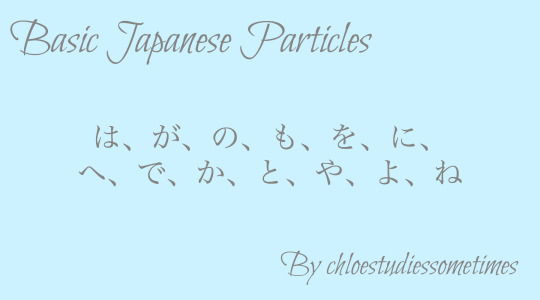
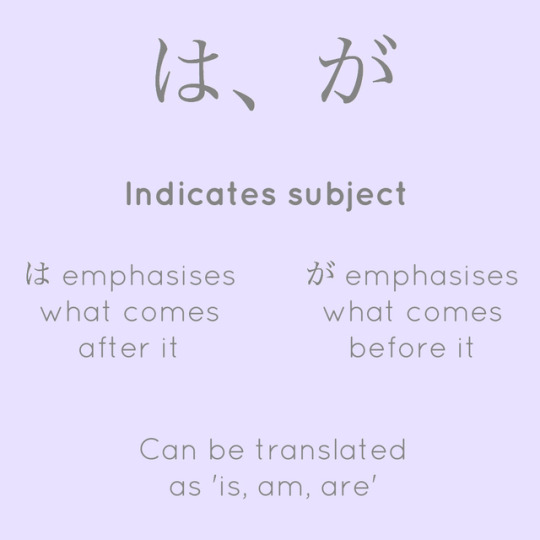



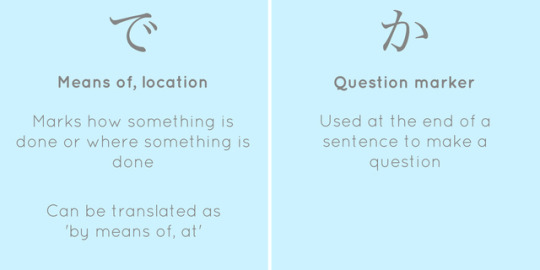

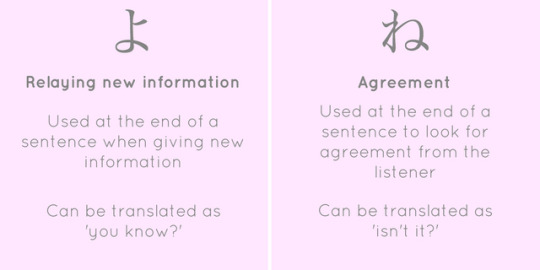
I’ve been meaning to make this post for a while, and I got an anon the other day asking about particles and a request from someone to make this post, so here it is! A list of basic particles and their usage! I hope this can help anyone struggling with particles and how to use them, but if I have made any mistakes please let me know ^^ (also please don’t remove my caption!)
15K notes
·
View notes
Text
Counting Objects in Japanese

To count object in Japanese, you will need to add counter as suffix. Different object require different counter. Below are some common & useful counters.
人 (nin)
Counting Human. Yes, it’s a kanji for human. And remember that 一人 (hitori) : one people and 二人 (futari) : two people. Are irregulars which you will often found in many occasion.
本 (hon)
Counting Cylindrical Objects such as pencil, tube, branch, etc Yes, it’s a kanji for book. In the old days, books are made in the form of a cylindrical scroll, so it’s kinda make sense To count a modern book, you use 冊 (satsu) instead.
回 (kai)
Counter for occurence. Like, one time or five times.
階 (kai)
Counter for floors of a building. 1st floor, 5th floor, and so on. Have similar reading and pattern with 回
枚 (mai)
Counter for thin, flat objects. Such as sheets of paper, plates, etc
個 (ko)
Counter for small and/or round items
杯 (hai)
Counter for cups, glasses or bowl.
匹 (hiki)
Counter for small animals, insects, fish, reptiles, etc
円 (en)
Counter for money
and so on , read the complete article here.
Happy learning °˖✧◝(⁰▿⁰)◜✧˖°
…………………………………………
Links:
• CrunchyNihongo - Easy to Learn Japanese Lessons Site
• Get our easy Japan lessons on your facebook timeline
• FREE DOWNLOAD! Resourceful app to start learning Japanese!
• Books to guide & help you learn Japanese
570 notes
·
View notes
Video
youtube
N2 Grammar (when, as soon as)
とたん vs かと思うと
外に出たとたんに寒さが襲ってきた。
When I went outside, the cold hit me.
お姉ちゃんがさっき帰ってきたかと思ったら、もういない?!
Just when my sister got home, she’s already gone?!
Both grammar structures have a sense of something happening immediately after something else has occurred (直後、瞬間的).
とたん has a sense of speed–that is Y happens relatively fast after X has occurred.
かと思うと has a surprise/unexpected appeal, as in something that is beyond your expectations or extreme occurred. Just when A happens, F happens (though you might’ve been expecting B).
Check out more videos for JLPT at 日本語の森
215 notes
·
View notes
Text
Introducing Language Printables

My boyfriend and I are trying to save up so we can rent a new place and get married, so we have been working hard on a new project: Japanese Learning Printables, which we’re selling on Etsy. He’s a professional graphic designer and I have been teaching languages since 2003, so we decided to put our professional skills together and design some products that we hope Japanese learners will find useful.
Here’s a brief overview of what we’ve made so far:
Language Study Printables Pack 1

This bundle contains eight different printables in PDF format, both in A4 and letter size. Colour and black and white versions are included.

There are New Kanji blank sheets for you to practice kanji, with spaces for mnemonics, stroke order, on’yomi and kun’yomi, example sentences and more. Language Exchange sheets allow you to document new vocabulary and phrases, as well as cultural points as you participate in language exchange, meaning you get more out of your experience and can review afterwards. There’s also space for feedback for your partner and goal tracking.

To increase productivity you can track your reading and study hours with these Reading Log and Study Log pages.

To keep track of new words or compounds you can use our New Vocabulary sheet, with space for readings, example sentences, so you can lean in context, and review tracking included.
Learning in real-life context is particularly difficult for self-studiers, so with this in mind we designed this Grocery List printable, which you prepare at home, as you would a normal list, then take shopping so that you can use Japanese in context, even if you’re in a non-Japanese environment.
Also included in the Language Study Printables Pack 1 are Anime Log and Drama Log trackers, where you can note down examples of words in context you encounter when watching Japanese TV, track where and when you heard them and monitor your reviews.

Beginners, Intermediate and Advanced Journal Prompt Printables
There are three different levels available individually, or you can buy the bundle and get all three at a discount. Again the printables come in PDF format, including both A4 and letter size versions.
Designed with self-studiers in mind, these packs cover basic to advanced Japanese, including topics on your interests, memories, goals, as well as your opinions on a variety of current events, cultural points and social issues.
Each pack contains 31 unique language prompts, one for every day of the month.
Beginners Journal Prompts should be good for self-studiers who are at around JLPT N5/N4 level, or who are working through Genki I and II. Topics include writing about your environment and interests, whilst giving you opportunities to use beginner level grammar and vocabulary. An English translation cheat sheet is included to help you if you get lost.
Intermediate Journal Prompts would best suit those at about JLPT N3/N2, or working through a textbook like Tobira. Topics include writing for different purposes, talking about culture, re-telling anecdotes and expressing your opinions. An English translation cheat sheet is included to help you if you get lost.
Advanced Journal Prompts are designed for those at N2/N1 JLPT level, or beyond. They are written by a native Japanese speaker and are designed to help you create independent texts on engaging and relevant topics, whilst using advanced language skills such as persuasion, criticism, and expressing nuanced opinions that often appears at this level.

We really hope that you will take a look at LanguagePrintables on Etsy and favourite our store. We put a lot of thought into making these as useful as possible, and so we would very much appreciate your support through buying or simply reblogging this post.
Thank you so much for taking the time to read this post, if you have any questions, please feel free to ask. If you have a request for a language learning printable you’d like to see on our store in the future, then please let us know!
5K notes
·
View notes
Text
Japanese Grammar Lesson: に行く(ni iku)

Yes, this is a part of the usage of particle に, but in this lesson, we focus on the combination of に and 行く. 行く (iku) means to go. You can conjugate the 行く normally.
This pattern use the Verb stem form. It’s a form where you conjugate a verb into ます form, but then you remove the ます.
Happy learning °˖✧◝(⁰▿⁰)◜✧˖°
…………………………………………
Links:
• CrunchyNihongo - Easy to Learn Japanese Lessons Site
• Get our easy Japan lessons on your facebook timeline
• FREE DOWNLOAD! Resourceful app to start learning Japanese!
614 notes
·
View notes